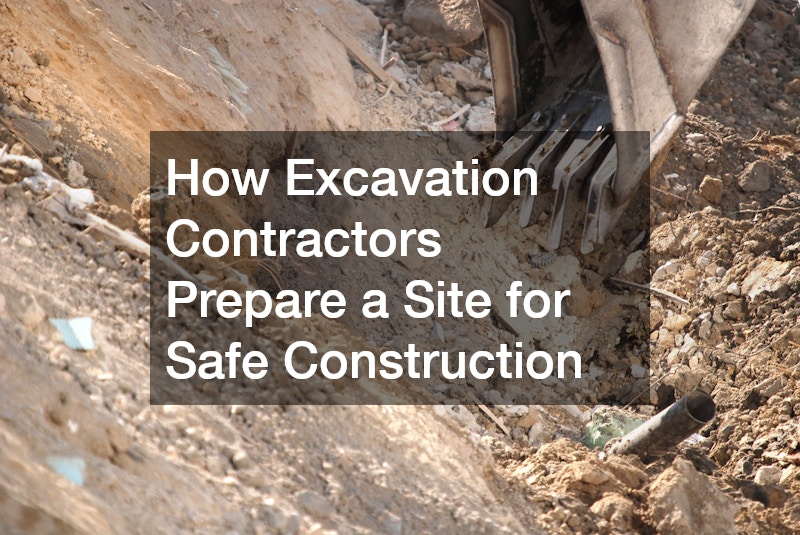The process of preparing a construction site through excavation is critical to ensuring a safe and successful building project. This article delves into the steps excavation contractors take to prepare sites for construction, focusing on safety measures, essential equipment, and environmental considerations. By understanding the intricacies involved in site preparation, stakeholders can appreciate the pivotal role these contractors play in laying the groundwork for construction.
Preliminary Inspections and Assessments Performed Before Excavation
Site Surveys
Before any excavation work begins, site surveys are conducted to assess the terrain and understand the area’s topographical features. This initial step is crucial as it helps in identifying any potential challenges that could impact the excavation process. By employing topographical maps and surveying tools, contractors gather vital data that guides the entire project planning phase.
These surveys also help in determining the boundaries and setting benchmarks, which are essential for maintaining accuracy during the excavation. Additionally, site surveys aid in understanding the existing landscape, which can affect water drainage and soil stability, both critical factors in safe construction. Through comprehensive surveys, contractors can make informed decisions to mitigate risks and optimize project efficiency.
Soil Testing
Soil tests are crucial in determining the soil’s stability and suitability for construction, ensuring it can support the planned structures. These tests involve analyzing soil composition, density, and moisture content to evaluate its bearing capacity. By understanding these properties, contractors can identify the potential for soil erosion or compaction, which can lead to future structural failures.
In addition to structural concerns, soil testing also helps in assessing environmental considerations. For instance, identifying soil contamination early in the process allows for remediation measures to be implemented, minimizing environmental impact. By addressing these concerns, excavation contractors can ensure that the construction site is both safe for workers and environmentally compliant.
Utility Mapping
Locating underground utilities is essential to prevent accidents and disruptions by mapping out water, gas, and electrical lines. Utility mapping technology, such as ground-penetrating radar, is employed to create detailed maps of subsurface utilities. This preventive measure minimizes the risk of damaging existing infrastructure during the excavation phase.
Accurately plotted utilities ensure that excavation work is planned around these crucial components, safeguarding workers and preventing service interruptions. Overlooking this aspect can lead to costly repairs and delays, highlighting the need for meticulous utility mapping. By coordinating with local utility companies, contractors verify the accuracy of data and ensure compliance with safety regulations.
How Contractors Ensure Safety During the Excavation Process
Implementing Protective Systems
Contractors install protective systems such as trench boxes and shoring to prevent collapses and ensure worker safety. These protective methods are designed to support the walls of the excavation, reducing the risk of cave-ins. By adhering to OSHA guidelines, contractors ensure that protective systems are properly installed and maintained throughout the project.
Regular inspections and adjustments of these systems are conducted to ensure their effectiveness, considering factors like soil type and weather conditions. This proactive stance not only safeguards workers but also helps to maintain project timelines and reduce potential liabilities. With appropriate protective systems in place, contractors can manage excavation risks effectively and promote a safe working environment.
Monitoring Weather Conditions
Weather conditions are closely monitored to avoid working in hazardous conditions that could lead to accidents. Real-time weather data allows contractors to make informed decisions on when to pause or proceed with excavation activities. Knowing that severe weather can dramatically affect soil stability, contractors remain vigilant to potential weather disruptions.
Adjusting work schedules based on weather forecasts not only protects workers but also prevents equipment damage and site degradation. This adaptive approach ensures that excavation processes continue smoothly without delays caused by unexpected weather events. Excelling in weather management reflects a contractor’s agility and preparedness, essential attributes for reliability in construction.
What Role Does Technology Play in Modern Excavation Practices?
Utilization of GPS and Drones
GPS and drones are utilized for precision mapping and monitoring, enhancing the accuracy and efficiency of excavation projects. These technologies provide real-time data, allowing contractors to make timely adjustments to project plans. With GPS systems guiding earth-moving machines, precision excavation is achieved, minimizing unnecessary soil displacement.
Drones offer aerial perspectives for a comprehensive overview of site conditions, facilitating advanced planning and real-time monitoring. The data gathered from drones can be used to create detailed site maps that enhance site management and resource allocation. This technology is invaluable in maintaining high levels of accuracy and efficiency throughout the excavation process.
3D Modeling and Simulation
3D modeling allows contractors to visualize the excavation process and plan accordingly, reducing the risk of errors. By simulating different scenarios, contractors can identify potential issues and develop solutions before actual work begins. This foresight minimizes on-site disruptions and facilitates smooth project progression.
Advanced modeling techniques also enable contractors to assess the impact of excavation on nearby structures and landscapes. By understanding these interactions, informed decisions can be made to protect existing infrastructure and environmental features. The strategic use of 3D modeling is a proactive measure that ensures closely aligned project outcomes to predefined objectives.
Excavation contractors play a pivotal role in the initial stages of construction by ensuring that sites are prepared safely and efficiently. By conducting thorough inspections, implementing robust safety measures, and utilizing advanced technology, they set the foundation for successful construction projects. As the industry continues to evolve, the role of excavation contractors remains indispensable in advancing safe and innovative building practices.




